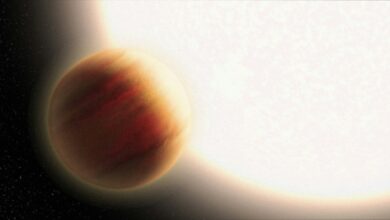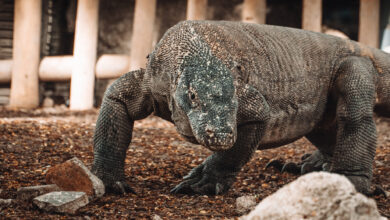17 Colourful Facts About Aurora Borealis
The Aurora Borealis, also known as the Northern Lights, is a natural phenomenon that creates a mesmerizing display of colourful lights in the night sky. It is caused by solar winds colliding with Earth’s magnetic field, creating a spectacle that is truly breath taking to witness. Here are some interesting facts about the Aurora Borealis:
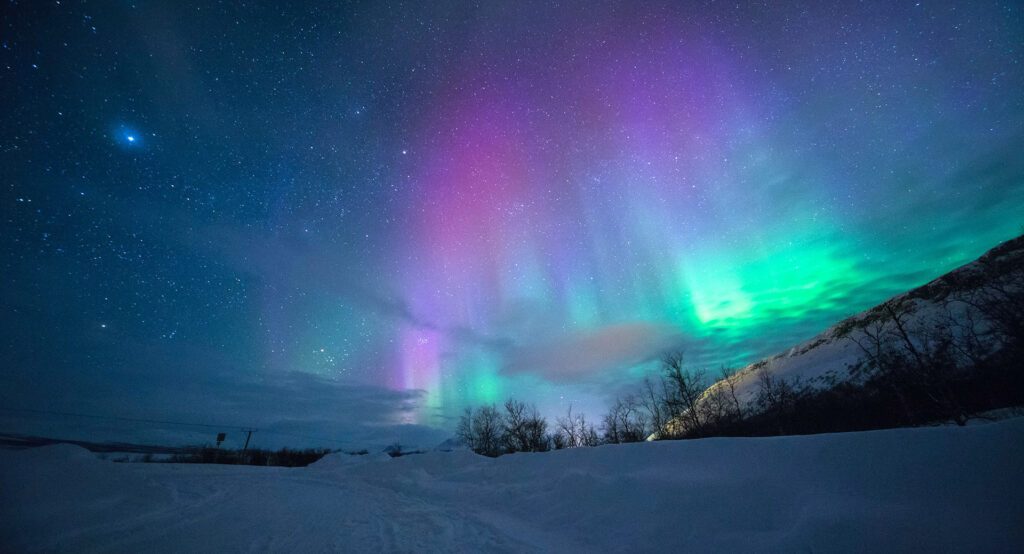
Aurora borealis, also known as the Northern Lights.
1 Is a natural phenomenon that occurs in the polar regions of the Earth. It is a colourful light display that appears in the night sky and is caused by the interaction between charged particles from the sun and the Earth’s magnetic field.
The Aurora Borealis typically appears as a greenish or yellowish glow that appears to dance and move in the sky. The colours can also range from pink, purple, blue, and red, depending on the type of gas molecules that are being ionized in the atmosphere.
The Aurora Borealis can be seen in the northern hemisphere, primarily in countries such as Norway, Sweden, Finland, Canada, and Alaska. In the southern hemisphere, a similar phenomenon called the Aurora Australis, or Southern Lights, can be seen in countries such as Australia, New Zealand, and Antarctica.
The Aurora Borealis is a breath-taking and awe-inspiring sight that has fascinated people for centuries. Many people travel to the polar regions to witness this natural wonder and experience the magic of the Northern Lights first-hand.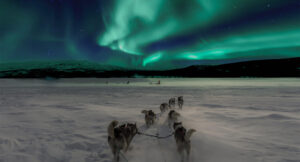
The Aurora Borealis is caused by interactions between the solar wind and the Earth’s magnetic field.
2 The solar wind is a stream of charged particles, mostly electrons and protons, that are constantly flowing from the Sun into space. When the solar wind collides with the Earth’s magnetic field, it causes the magnetic field to stretch and warp, which can create areas of intense electrical currents and plasma in the upper atmosphere.
These charged particles and plasma then collide with atoms and molecules in the Earth’s atmosphere, such as nitrogen and oxygen, causing them to become excited and emit light in the form of the Aurora Borealis.
The colours of the aurora depend on the type of gas molecules that are being ionized and excited in the atmosphere, and the altitude at which the interactions are taking place. Oxygen atoms, for example, emit a greenish-yellow light at lower altitudes, and a red light at higher altitudes, while nitrogen molecules emit a blue or purplish-red light.
Overall, the Aurora Borealis is a fascinating and beautiful natural phenomenon that results from the interaction between the solar wind and the Earth’s magnetic field.
The colors of the aurora borealis are caused by different gases in the Earth’s atmosphere.
3 Primarily oxygen and nitrogen. When the charged particles collide with oxygen atoms in the Earth’s atmosphere, they can excite the atoms and cause them to emit light. The specific color of the light emitted depends on the altitude at which the interaction occurs.
For example, excited oxygen atoms at lower altitudes can emit a greenish-yellow light, while those at higher altitudes can emit a red light.
Similarly, when the charged particles collide with nitrogen molecules in the Earth’s atmosphere, they can also cause the molecules to become excited and emit light. The specific colour of the light emitted by excited nitrogen molecules depends on the amount of energy they have absorbed.
Nitrogen molecules excited by lower energy collisions can emit a blue or purplish-red light, while those excited by higher energy collisions can emit a red or pinkish light.
The colours of the Aurora Borealis can also be affected by other factors such as the strength of the solar wind, the orientation of the Earth’s magnetic field, and the time of day.
Overall, the Aurora Borealis is a fascinating and beautiful natural phenomenon that results from the complex interaction of charged particles from the solar wind with different gases in the Earth’s atmosphere.
The aurora borealis can be seen from many different parts of the.
4 Primarily in countries located within or near the Arctic Circle. Some of the best places to see the Aurora Borealis include Norway, Sweden, Finland, Iceland, Canada, and Alaska.
However, the visibility of the Aurora Borealis can also depend on a number of factors such as the time of year, weather conditions, and the level of solar activity. In general, the best time to see the Aurora Borealis is during the winter months when the nights are longer and darker. This is also when the Earth’s magnetic field is most aligned with the solar wind, increasing the chances of seeing the Northern Lights.
The Aurora Borealis can also be visible from other parts of the world that are closer to the equator, although it is much rarer. In these regions, the Aurora Borealis can only be seen during periods of intense solar activity and geomagnetic storms.
Overall, the Aurora Borealis is a fascinating natural phenomenon that can be seen from many different parts of the world, although the best viewing opportunities are typically in countries located within or near the Arctic Circle.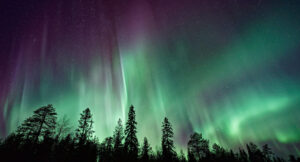
The best time to see the aurora borealis is during the winter months.
5 When the nights are longer and darker in the northern hemisphere. This is because the Aurora Borealis is a natural phenomenon that can only be seen in the dark, and the winter months provide more hours of darkness for viewing.
In addition to the longer nights, the winter months are also typically less cloudy and have clearer skies, which can improve visibility of the Aurora Borealis.
The months between September and March are generally considered the best time to see the Aurora Borealis, with peak viewing occurring in December and January. However, the visibility of the Aurora Borealis can also depend on other factors such as solar activity, weather conditions, and the level of geomagnetic activity.
It’s also important to note that the Aurora Borealis can be visible during other times of the year, although the viewing conditions may not be as optimal as during the winter months. Overall, the best time to see the Aurora Borealis is during the winter months in countries located within or near the Arctic Circle.
The intensity of the aurora borealis varies depending on the activity of the sun.
6 Specifically on the number and intensity of solar flares and coronal mass ejections (CMEs) that are ejected from the Sun.
When the Sun is active and producing a large number of solar flares and CMEs, it can cause an increase in the intensity and frequency of the Aurora Borealis. This is because these events can send streams of charged particles, such as electrons and protons, toward the Earth’s magnetic field, which can then create the conditions necessary for the Aurora Borealis to occur.
Conversely, when the Sun is less active, there are fewer solar flares and CMEs, which can result in a decrease in the intensity and frequency of the Aurora Borealis. This can make it more difficult to see the Aurora Borealis, especially in regions that are further from the poles where it is typically less intense.
The intensity of the Aurora Borealis can also be affected by other factors such as the Earth’s magnetic field and the altitude at which the charged particles interact with the atmosphere. Overall, the intensity of the Aurora Borealis can vary depending on the activity of the Sun and other factors that influence its formation.
The Aurora Borealis can be seen from space by astronauts and satellites orbiting the Earth.
7 In fact, images and videos of the Aurora Borealis from space can provide a unique and stunning perspective of this natural phenomenon.
Astronauts aboard the International Space Station (ISS) have captured many amazing images and videos of the Aurora Borealis from their vantage point high above the Earth. These images and videos show the Aurora Borealis as a glowing and shimmering band of light that stretches across the polar regions of the Earth.
In addition to providing a unique perspective on the Aurora Borealis, observations of the phenomenon from space can also help scientists better understand the underlying processes that drive it. For example, satellites equipped with special instruments can measure the charged particles and magnetic fields that are associated with the Aurora Borealis, providing valuable insights into its formation and behaviour.
Overall, the Aurora Borealis is not only a stunning natural phenomenon visible from the ground, but also a fascinating sight to behold from space.
The Inuit people of Canada and Greenland have long associated the aurora borealis with spiritual and cultural beliefs.
8 In Inuit mythology, the Aurora Borealis is often seen as a bridge between the natural and spiritual worlds, and is associated with various spirits and legends.
For example, some Inuit tribes believed that the Aurora Borealis was a celestial game played by the spirits of the dead, while others saw it as a signal of good or bad luck. Some Inuit cultures also believed that whistling or making loud noises during the Aurora Borealis could anger the spirits and bring misfortune.
In addition to their spiritual significance, the Aurora Borealis also played a practical role in the lives of the Inuit people. For example, the timing and intensity of the Aurora Borealis could be used to predict weather patterns, and some Inuit tribes believed that the Aurora Borealis could even help with hunting by illuminating the night sky and making it easier to track animals.
Today, the Aurora Borealis remains an important part of Inuit culture and traditions, and many communities continue to celebrate and honour this natural phenomenon in various ways. Overall, the Aurora Borealis has long been a source of inspiration and wonder for the Inuit people of Canada and Greenland, and continues to hold great cultural and spiritual significance for them.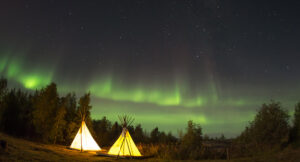
The aurora borealis has inspired many works of art, literature, and music over the.
9 Artists and writers have been captivated by the beauty and mystery of the Aurora Borealis, and have used it as a source of inspiration for their works.
For example, many painters have created beautiful landscapes that feature the Aurora Borealis as a prominent element. One of the most famous examples is the painting “The Great Wave off Kanagawa” by the Japanese artist Hokusai, which depicts a massive wave crashing against a shore beneath a vibrant display of the Aurora Borealis.
In literature, the Aurora Borealis has been used as a metaphor for a range of emotions and experiences. For example, the American poet Robert Frost wrote a poem titled “The Star-Splitter,” which uses the Aurora Borealis as a symbol for the infinite possibilities of the universe.
In music, the Aurora Borealis has inspired many composers to create works that evoke its ethereal and otherworldly qualities. One example is the composition “Aurora Borealis” by the Finnish composer Einojuhani Rautavaara, which features shimmering strings and haunting vocal lines that evoke the beauty and mystery of the Aurora Borealis.
Overall, the Aurora Borealis has inspired many artists, writers, and musicians throughout history, and continues to be a source of wonder and inspiration for many today.
In addition to the aurora borealis, there is also a similar phenomenon called the aurora australis, or Southern Lights.
10 The Aurora Australis is essentially the southern hemisphere counterpart to the Aurora Borealis, and is caused by the same interactions between the solar wind and the Earth’s magnetic field.
Like the Aurora Borealis, the Aurora Australis produces a spectacular display of colourful lights in the night sky, with hues of green, pink, and purple often visible. However, the Aurora Australis is generally less well-known than the Aurora Borealis, as it is only visible from certain regions of the southern hemisphere, such as Antarctica, southern parts of Australia, and New Zealand.
Despite its relative obscurity, the Aurora Australis is still a breath-taking natural phenomenon that has inspired many artists, photographers, and scientists over the years. And like the Aurora Borealis, it serves as a reminder of the beauty and complexity of our planet and the universe as a whole.
The scientific study of the Aurora Borealis (and its southern hemisphere counterpart, the Aurora Australis) is called aurorae physics.
11 Aurorae physics is a specialized field of study that focuses on understanding the physical processes and mechanisms that produce the Aurora Borealis.
Aurorae physics involves a range of scientific disciplines, including astronomy, atmospheric science, and plasma physics. Researchers in this field use a variety of methods to study the Aurora Borealis, including ground-based observations, satellite measurements, and computer simulations.
By studying the Aurora Borealis, scientists can gain insights into the fundamental processes that shape our planet’s magnetic field and upper atmosphere. They can also use this knowledge to develop better tools for monitoring space weather and predicting the effects of solar storms on Earth.
Overall, aurorae physics is a fascinating and important field of study that has contributed greatly to our understanding of the natural world and the universe beyond.
The Aurora Borealis (and its southern hemisphere counterpart, the Aurora Australis) can interfere with radio and satellite communications.
12 The Aurora Borealis is caused by high-energy particles from the sun colliding with the Earth’s magnetic field and upper atmosphere, which can create disturbances in the ionosphere, a layer of charged particles that surrounds the Earth.
These disturbances can affect radio waves, causing them to scatter or reflect in unexpected ways. This can make it difficult or impossible to transmit or receive radio signals, particularly at high frequencies used for satellite communications.
In addition to interfering with communications, the Aurora Borealis can also disrupt power grids and other electrical systems. The charged particles that produce the Aurora Borealis can induce electrical currents in power lines and other conductive materials, which can cause voltage spikes and other disruptions.
To mitigate the effects of the Aurora Borealis and other space weather phenomena, scientists and engineers have developed a range of techniques and technologies, such as specialized radio antennas and power grid monitoring systems.
These tools help to minimize the impact of the Aurora Borealis and ensure that critical infrastructure remains functional, even during periods of heightened solar activity.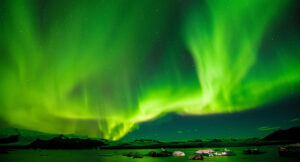
The intensity of the Aurora Borealis (and the Aurora Australis) is measured on a scale known as the “KP index”, which ranges from 0 to 9.
13 However, the KP index is not a measure of the overall intensity of the Aurora Borealis, but rather an indicator of the level of geomagnetic activity occurring at a particular time.
The KP index is based on measurements of the Earth’s magnetic field at several locations around the world. The index is used by scientists and forecasters to predict the likelihood and intensity of auroral displays. A KP index of 0 indicates very little geomagnetic activity, while a KP index of 9 indicates a major geomagnetic storm.
While there is a general correlation between higher KP indices and more intense auroral displays, other factors such as cloud cover, moonlight, and local weather conditions can also affect the visibility of the Aurora Borealis. Additionally, individual auroral displays can vary widely in intensity and duration, even when occurring during periods of high KP activity.
So, while the KP index can provide a useful indicator of when and where to look for the Aurora Borealis, it is not a direct measure of the intensity of the phenomenon itself.
The aurora borealis can take many different shapes and forms.
14 Depending on a variety of factors such as the energy and direction of the incoming solar particles, the location and orientation of the Earth’s magnetic field, and the characteristics of the upper atmosphere.
Some common shapes and forms of the Aurora Borealis include:
- Arcs or curtains: These are the most common forms of the Aurora Borealis and appear as bright, colourful arcs or curtains that can stretch across the sky.
- Patches or blobs: These are irregularly shaped areas of diffuse or patchy auroral light.
- Rays or bands: These are narrow, vertical streaks of light that can sometimes appear to be moving or pulsing.
- Coronas or halos: These are circular or oval-shaped auroral displays that can surround the observer.
- Flares or bursts: These are sudden and short-lived eruptions of intense auroral activity that can appear as bright flashes or explosions of light.
The exact appearance of the Aurora Borealis can vary widely depending on the observer’s location and viewing conditions, as well as the intensity and duration of the auroral activity. This variability is part of what makes the Aurora Borealis such a fascinating and awe-inspiring natural phenomenon.
The Aurora Borealis is a visible manifestation of the Earth’s magnetic field interacting with charged particles from the sun.
15 The Earth’s magnetic field is generated by the motion of molten iron in the planet’s core, which creates a complex and ever-changing magnetic field that surrounds the Earth.
The charged particles from the sun, also known as the solar wind, interact with the Earth’s magnetic field and are guided towards the polar regions. As these particles collide with the atoms and molecules in the upper atmosphere, they release energy in the form of light, which produces the colourful and dynamic display of the Aurora Borealis.
So, in a sense, the Aurora Borealis can be seen as a visual representation of the Earth’s magnetic field, as it shows the way that this field interacts with the charged particles from the sun to create a spectacular natural display in the sky.
The Aurora Borealis is one of the most spectacular and awe-inspiring natural phenomena on Earth.
16 The stunning display of colourful lights dancing across the night sky is a sight that is difficult to describe in words, and is truly a testament to the beauty and power of nature.
For many people, seeing the Aurora Borealis in person is a once-in-a-lifetime experience, and can be a deeply moving and spiritual moment. The sense of wonder and awe that comes from witnessing such a powerful and mysterious natural event can be truly transformative, and has inspired countless works of art, literature, and music over the centuries.
Whether viewed as a scientific phenomenon or as a spiritual and cultural symbol, the Aurora Borealis is a reminder of the incredible beauty and complexity of our planet and the universe around us, and continues to captivate and inspire people of all ages and backgrounds.
The best way to experience the aurora borealis is to travel to a location where it is visible.
17 The Aurora Borealis can be seen from many different parts of the world, but it is most commonly visible in the polar regions, including northern Canada, Alaska, Scandinavia, and Iceland.
To increase your chances of seeing the Aurora Borealis, it is important to plan your trip carefully and choose the right time of year. The Aurora Borealis is generally most visible during the winter months, when the nights are longest and the skies are darkest.
It is also important to find a location with clear skies and minimal light pollution, as this will help to ensure the best possible viewing conditions. Many tour operators and travel companies offer packages and tours specifically designed for Aurora Borealis viewing, which can include everything from transportation and accommodation to guided tours and expert advice on how to maximize your chances of seeing the lights.
Whether you are a seasoned traveller or a first-time visitor, experiencing the Aurora Borealis in person is a truly unforgettable and life-changing experience that is sure to leave you with memories that will last a lifetime.

